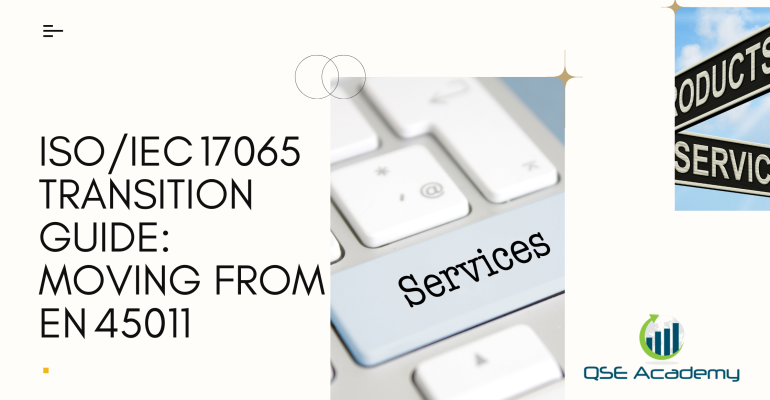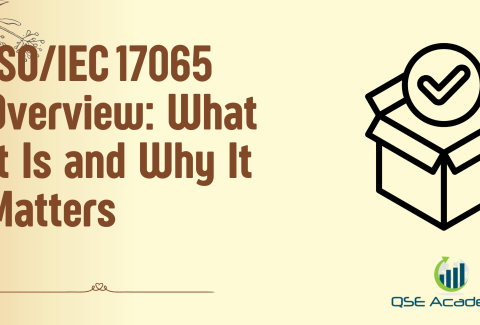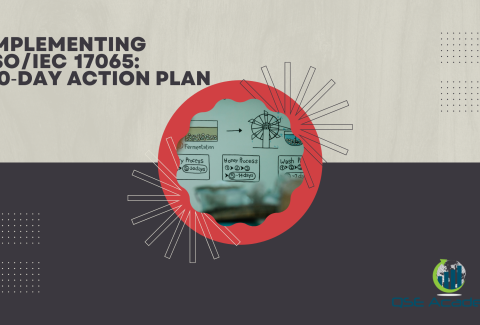ISO/IEC 17065 Transition Guide: Moving from EN 45011
Why the Transition from EN 45011 to ISO/IEC 17065 Matters
Here’s what becomes obvious the moment a certification body starts reviewing its system: transitioning from EN 45011 to ISO/IEC 17065 is more than updating terminology. It’s a shift toward a clearer, more consistent, and more globally aligned framework for product certification.
This pillar guide helps you navigate that shift with clarity. You’ll understand what changed, how to update your processes, which areas require deeper attention, and how to implement the transition without disrupting ongoing certification activities.
Everything here is structured to give you a complete roadmap—from clause alignment to scheme updates, impartiality expectations, competence requirements, surveillance redesign, and transition-focused internal audits.
Understanding the Shift from EN 45011 to ISO/IEC 17065
The move from EN 45011 to ISO/IEC 17065 wasn’t just a rebranding exercise. It aligned product certification requirements with the ISO/CASCO structure used across other conformity-assessment standards. The result is a more coherent, risk-aware, and transparent framework.
Key differences include:
- Updated clause structure matching CASCO’s consistent layout
- Stronger emphasis on impartiality and conflict prevention
- Clearer requirements for decision independence
- More explicit expectations for certification schemes
- A greater focus on transparency and information for clients
- Integration of risk reasoning into evaluation and decision-making
Many certification bodies underestimate these changes because EN 45011 already felt familiar and stable. ISO/IEC 17065 raises the bar by requiring clearer justification, stronger controls, and better-documented evidence.
Common Mistake: Treating the transition as a document-title update instead of a system-wide alignment activity.
 Gap-Analysis for EN 45011 to ISO/IEC 17065 Transition
Gap-Analysis for EN 45011 to ISO/IEC 17065 Transition
A well-executed gap-analysis is the backbone of a successful transition. It shows what’s aligned, what’s outdated, and what needs a complete redesign.
Your gap-analysis should evaluate:
- Clause alignment
- Process logic
- Role separation
- Documentation terminology
- Certification scheme structure
- Impartiality controls
- Decision criteria and evidence trails
- Competence documentation
- Surveillance rules
Use a structured crosswalk approach:
EN 45011 requirement → ISO/IEC 17065 requirement → current evidence → action needed
This transforms the transition into a clear, step-by-step plan rather than a scattered effort.
Pro Tip: Treat any undocumented process as a gap, even if the team “already knows how it’s done.” ISO/IEC 17065 requires evidence.
Common Pitfall: Updating manuals but leaving templates and forms unchanged.
Updating Certification Schemes to Meet ISO/IEC 17065 Requirements
Certification schemes are one of the most affected areas during transition. Under ISO/IEC 17065, schemes must be specific, operational, and complete—not just general guidance.
Your updated scheme should include:
- Scope and product categories
- Evaluation methods and sampling logic
- Required test methods and acceptance criteria
- Criteria for granting, maintaining, suspending, or withdrawing certification
- Decision rules and escalation paths
- Surveillance types and frequencies
- Conditions for certification use and client obligations
- Transparency requirements for published information
Most gaps occur when schemes are vague or assume evaluator discretion. ISO/IEC 17065 expects clear, repeatable rules—not interpretation.
Pro Tip: Define decision triggers explicitly. This ensures consistent outcomes across evaluators and products.
Common Mistake: Retaining EN 45011-era surveillance wording that isn’t risk-based.
Strengthening Impartiality & Risk Management
ISO/IEC 17065 expands impartiality requirements significantly. Certification bodies must identify, document, analyze, and mitigate impartiality risks—continuously, not occasionally.
Key expectations:
- Active impartiality committee oversight
- Documented risk assessments
- Evidence of regular monitoring
- Controls covering financial, operational, and relationship-based risks
- Proof that staff and subcontractors avoid consultancy influence
- Separation between commercial and certification decision functions
Real-Life Insight (only once): In one transition project, a certification body believed its impartiality risks were “minimal.” Once their processes were mapped, hidden risks emerged—subcontracted evaluators who also consulted for some clients. This wasn’t intentional, but it showed how easily risk can hide without structured analysis.
Pro Tip: Add impartiality checks inside your certification workflow—not only in a general procedure.
Common Pitfall: Assuming low risk equals no need for documentation.
Updating Decision-Making Processes & Role Separation
Decision independence is one of the most scrutinized areas in ISO/IEC 17065. Evaluators, reviewers, and decision-makers must have clearly separated responsibilities, supported by competence, evidence, and documented logic.
Your transition must ensure:
- Evaluators do not perform final decisions
- Reviewers check completeness and correctness
- Decision-makers verify impartiality and evidence
- Competence records match assigned responsibilities
- Decision rules follow the updated scheme
- Decision rationales are documented consistently
Pro Tip: Build a decision matrix assigning roles and backups. It prevents improvised role-mixing during busy periods.
Common Mistake: Allowing evaluators to influence decisions “because they know the file best.”
Updating Documentation, Templates & Records
Document control becomes even more important during transition. ISO/IEC 17065 requires consistent terminology, structure, and traceability across all documents—not just the manual.
You should update:
- Manuals and procedures
- Evaluation templates
- Decision forms
- Sampling plans
- Scheme annexes
- Surveillance checklists
- Competence matrices
- Complaint and appeal forms
- Public-facing information
Pro Tip: Update bottom-level operational templates first—your team uses these every day.
Common Pitfall: Leaving EN 45011 references scattered across old templates.
Competence Requirements & Resource Management
ISO/IEC 17065 expects certification bodies to define, assess, and maintain competence for all roles influencing certification outcomes.
Transition requires:
- Updated competence criteria for evaluators, reviewers, decision-makers
- Evidence of qualification, training, and ongoing evaluation
- Subcontractor competence verification
- Competence matrices linked to specific activities
- Training plans reflecting updated clause requirements
Pro Tip: Link each competence requirement directly to a certification function—it strengthens audits and clarifies expectations.
Common Mistake: Using generic job descriptions that don’t match decision-making or evaluation responsibilities.
Surveillance Design & Ongoing Compliance Monitoring
Surveillance must now be justified, risk-driven, and supported by clear evidence. ISO/IEC 17065 expects surveillance plans that are proportionate to product risk, certification model, and scheme rules.
Your updated surveillance design should define:
- Surveillance types (testing, on-site review, document review, market surveillance)
- Frequency based on risk
- Evidence expectations
- Triggers for additional surveillance
- Monitoring methods for certified products
- Conditions for suspension or withdrawal
Pro Tip: Build a risk-based matrix for surveillance frequency—it streamlines decision-making.
Common Pitfall: Applying uniform annual surveillance to every product category without validation.
Internal Audits During Transition
Internal audits are the most reliable quality checkpoint during transition. They reveal gaps long before an accreditation assessor arrives.
Your internal audits should:
- Cover all updated ISO/IEC 17065 requirements
- Verify documentation alignment
- Test impartiality and decision independence
- Review updated scheme logic
- Check competence records
- Review published certification information
- Confirm implementation, not just documentation
Pro Tip: Include website and public information reviews—assessors always check them.
Common Pitfall: Closing non-conformities on paper without verifying that operational behavior has changed.
Communication, Appeals & Complaints Management
ISO/IEC 17065 raises expectations for transparency and client-facing clarity. Transition requires updated communication, complaint handling, and appeals processes.
Your transition updates should ensure:
- Clear, accessible certification rules
- Published information to clients and the public
- Distinct procedures for appeals vs. complaints
- Training so staff know how to handle both
- Alignment between internal rules and public-facing documents
Pro Tip: Assign one person as the owner of public information updates.
Common Mistake: Updating internal procedures but forgetting to update the website.
FAQs
How long does the transition from EN 45011 to ISO/IEC 17065 normally take?
Typically 3–6 months depending on system maturity, documentation volume, and team availability.
Do we need to completely rewrite our certification scheme?
Only if the current one lacks sampling logic, decision criteria, or surveillance rules. Otherwise, structured updates work.
Which team members should be involved in the transition?
Evaluation staff, decision-makers, impartiality committee, document control, training coordinators, and leadership.
Conclusion — Moving from EN 45011 to ISO/IEC 17065 with Clarity
Transitioning to ISO/IEC 17065 strengthens your certification body. It sharpens impartiality, clarifies decision-making, improves scheme structure, and enhances transparency. With a clear roadmap—gap-analysis, updated schemes, revised documentation, strengthened competence, and meaningful internal audits—you can transition confidently and demonstrate full alignment with the standard.
If you want help turning this guide into a structured transition plan or need templates for clause mapping or scheme updates, just let me know.
Melissa Lavaro is a seasoned ISO consultant and an enthusiastic advocate for quality management standards. With a rich experience in conducting audits and providing consultancy services, Melissa specializes in helping organizations implement and adapt to ISO standards. Her passion for quality management is evident in her hands-on approach and deep understanding of the regulatory frameworks. Melissa’s expertise and energetic commitment make her a sought-after consultant, dedicated to elevating organizational compliance and performance through practical, insightful guidance.









